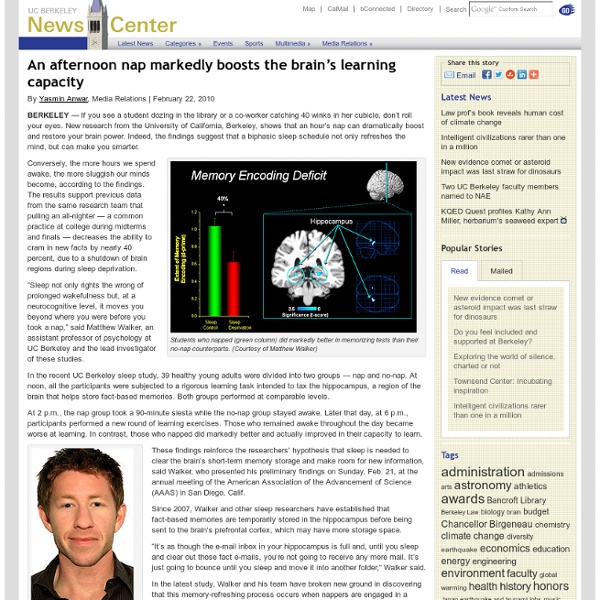Is the Internet Warping Our Brains? - Technology
Is this a bad thing? Not necessarily, says Sparrow. For instance, for years people in the educational community have known that rote learning—that is, forcing children to memorize facts and dates—is a poor way to educate. If that's the case, allowing computers to do some of the memorizing for us might be a way to focus more on the more philosophical aspects of learning.
Color: Meaning, Symbolism and Psychology
Green occupies more space in the spectrum visible to the human eye and is second only to blue as a favorite color. Green is the pervasive color in the natural world that is an ideal backdrop in interior design because we are so used to seeing it everywhere. The natural greens, from forest to lime, are seen as tranquil and refreshing, with a natural balance of cool and warm (blue and yellow) undertones. Green is considered the color of peace and ecology.
Hypnagogia and Hypnopompia
Hypnagogia is the imagery, sounds and strange bodily feelings that are felt at “sleep onset.” This is a simplification though, as researchers have noted hypnagogic imagery in the lab at periods of quiet wakefulness as well as stage 1 sleep. Others have correlated hypnagogia with pre-sleep alpha waves and also REM intrusion into sleep onset. The truth is that the wake-sleep transition is still not understood. And neither are its trippy visuals. whispy lights, multi-dimentional geometric objects, or a sudden image like a stranger’s face
The Brain's Dark Energy
Imagine you are almost dozing in a lounge chair outside, with a magazine on your lap. Suddenly, a fly lands on your arm. You grab the magazine and swat at the insect. What was going on in your brain after the fly landed? And what was going on just before? Many neuroscientists have long assumed that much of the neural activity inside your head when at rest matches your subdued, somnolent mood.
Neuroscience
Neuroscience is the scientific study of the nervous system.[1] Traditionally, neuroscience has been seen as a branch of biology. However, it is currently an interdisciplinary science that collaborates with other fields such as chemistry, computer science, engineering, linguistics, mathematics, medicine and allied disciplines, philosophy, physics, and psychology. It also exerts influence on other fields, such as neuroeducation[2] and neurolaw.
Power Napping for Increased Productivity, Stress Management and Health - Take a Power Nap - Power Nap and The Benefits of Sleep
Why A Power Nap? Facts on Sleep: While small children typically take naps in the afternoon, our culture generally frowns upon mid-day sleep; however, even in those who get enough sleep (but particularly in those who don’t), many people experience a natural increase in drowsiness in the afternoon, about 8 hours after waking. And research shows that you can make yourself more alert, reduce stress, and improve cognitive functioning with a nap. Mid-day sleep, or a ‘power nap’, means more patience, less stress, better reaction time, increased learning, more efficiency, and better health. Here’s what you need to know about the benefits of sleep and how a power nap can help you! How Much Sleep Do You Need?
Lucid Dreaming
By lucid dreaming, you can gain complete control over the one place that no one will ever care about: your imagination. Just The Facts Lucid dreaming is a scientifically proven phenomenon. While some get into lucid dreaming in order to treat chronic nightmares, or to experience all facets of the human experience, approximately 99.8% of people use it as a tool for cheap and interactive 3D porn. A lucid dream is a dream in which the dreamer is aware that he or she is dreaming, and he or she can even choose to control and manipulate his or her dream.
Brain mechanism recruited to reduce noise during challenging tasks
New research reveals a sophisticated brain mechanism that is critical for filtering out irrelevant signals during demanding cognitive tasks. The study, published by Cell Press in the February 26 issue of the journal Neuron, also provides some insight into how disruption of key inhibitory pathways may contribute to schizophrenia. "The ability to keep track of information and one's actions from moment to moment is necessary to accomplish even the simple tasks of everyday life," explains senior study author, Dr. Helen Barbas from Boston University and School of Medicine. "Equally important is the ability to focus on relevant information and ignore noise."
10 Practical Uses For Psychological Research in Everyday Life
People love to give each other advice. The web is full to bursting with all types of pseudo-psychological advice about life. The problem is, how much of this is based on real scientific evidence? Well, here on PsyBlog we’ve got the scientific evidence.
Naps, Learning and REM : The Frontal Cortex
It’s a shame that we stop encouraging naps once the preschool years are over. After all, there’s a growing body of scientific evidence that the afternoon siesta is an important mental tool, which enhances productivity, learning and memory. (It’s really much more effective than a cup of coffee.) Here’s the Times: Have to solve a problem?
Neuron : Temporally Structured Replay of Awake Hippocampal Ensemble Activity during Rapid Eye Movement Sleep
To view the full text, please login as a subscribed user or purchase a subscription. Click here to view the full text on ScienceDirect. Fig. 1 Behavioral Task and Hippocampal Unit Activity (A) Schematic of the four-trial sequence in the circular track task. A single trial consisted of travel from the start location to a removable food well placed at the goal location, followed by food consumption; in any given trial the goal was located at a position 270° clockwise from the start.



